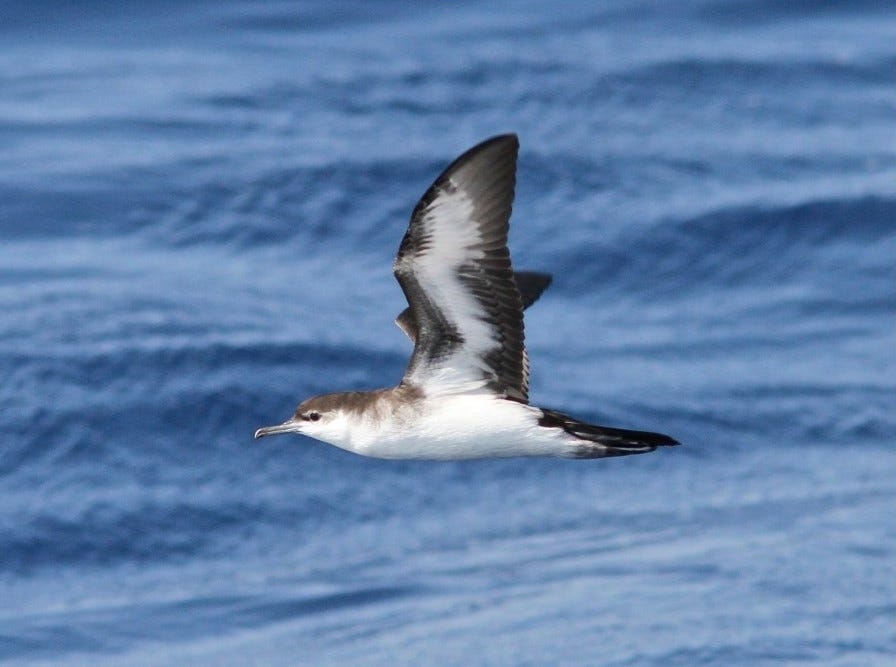
Beginning in late November, a sound resonates on the waterfront. It is distinctive and almost seems like a laugh. Some nights it is one voice. On others there are many. It is the call of the Sargasso Shearwater.
Sargasso Shearwater Recording November 25, 2024 - Shoal Bay East Anguilla
Their vocalizations are described as follows:
“A rhythmic, wheezing, fairly fast-paced, bleating call comprising 4–5 syllables, which is typically repeated several times in rapid succession, transcribed h'whieh-whieh huhr, h'whieh-whieh-huhr..., or wh'whieh-whieh h'hr (4). Described as sounding like a “squeaky, strangled” Manx Shearwater (Puffinus puffinus), with sexual dimorphism similar to in other shearwaters, i.e., female calls being lower in frequency and harsher (more gravelly) than those of males (4). Most populations are strictly nocturnal at colonies, and therefore only call by night. Generally silent at sea.”
Previously known as the Audubon’s Shearwater, the Sargasso Shearwater was renamed in 2024 as described in Birds of the World:
“This seabird is characterized by its largely black upperparts and white underparts, and is not unlike the generally more familiar Manx Shearwater (Puffinus puffinus). Until recently, some ten subspecies of the Sargasso Shearwater were generally recognized, distributed throughout much of the world’s tropical oceans. However, their taxonomy has been heavily debated over the course of the last couple of decades, and considerable systematic rearrangement is now generally awhicccepted, especially as a result of vocal and molecular research. As currently constituted, Sargasso Shearwater is now considered to comprise just two subspecies, both of which are largely or wholly confined as breeding birds to the Caribbean region, with the exception of populations, provisionally assigned to this species, nesting on islands off eastern Brazil. A third Neotropical taxon, long united with the present species, is now also recognized at species level, namely Galapagos Shearwater (Puffinus subalaris). The latter population is distinctly unusual in that the birds are strictly diurnal, never flying around their colonies by night.”
I was first introduced to this species while managing the Dog Island Restoration Project (2011-12). A single bird was found nesting in the island’s cliffs. Since then, my exposure has been along the northern coast of Anguilla and during the evening hours, as they feed on turbulent seas in search of fish and squid.
“Field Identification
27.0–36.2 cm; 138–290 g (1, 2, 3); wingspan 64–74 cm (1). Small, dark-and-white shearwater with comparatively short broad wings and long rounded tail.”
Further details include:
“Bare Parts
Bill and Gape
Bill grayish or blue-gray, often duskier on culmen and blacker at tip, with blackish tubes.
Iris
Irides dark brown.
Legs and Feet
Legs and feet pale pink, with outer side of tarsus and outer toes variably tinged dusky or blackish. Some birds, however, have the legs and toes bluish with pinkish webs, and these are thought to be juveniles (5, 4).”
I suspect but have not confirmed, that this species nests in small numbers in the rocks along the coast.
They lay one white egg which is incubated over 44 to 60 days. The chicks fledge between 62 and 100 days.
This bird is part of the pleasant rhythm of the night that makes up coastal living in Anguilla.
You can learn more about this interesting species from the Birds of the World link below.
I found this YouTube video of the birds along the North Carolina coast. I thought you might enjoy it.





Sooo interesting. Thank you for taking the time to share with us. 🪶♥️